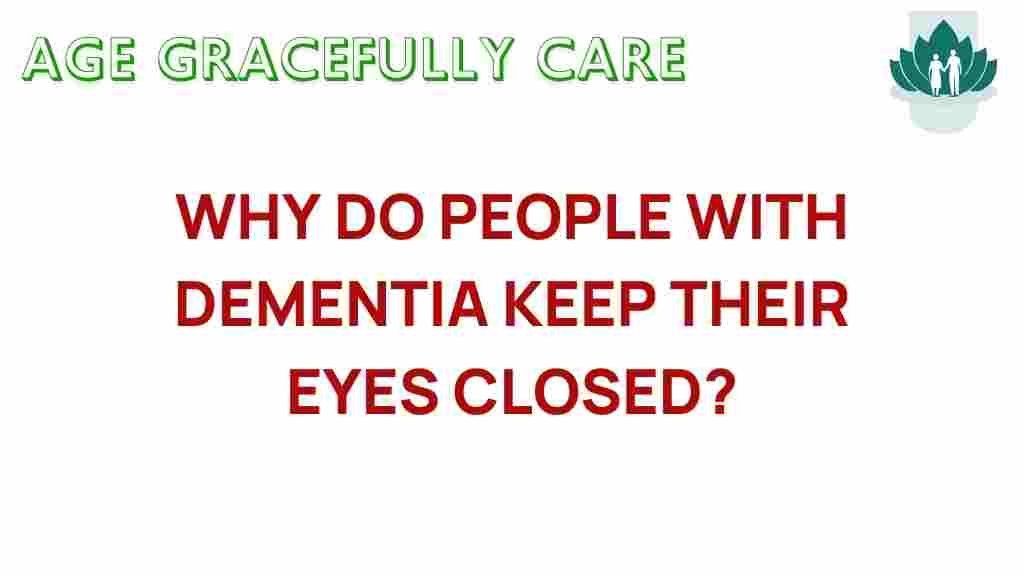The Hidden Reasons Behind Closed Eyes in Dementia Patients
Dementia is a complex neurological condition that affects millions of elderly individuals worldwide. One of the often-overlooked symptoms in dementia patients is the tendency to keep their eyes closed. This behavior can be puzzling for caregivers and family members, raising questions about its causes and implications for patient care. Understanding the reasons behind this behavior is essential for enhancing communication, ensuring better mental health, and providing effective support for those experiencing cognitive decline.
Understanding Dementia and Its Symptoms
Dementia encompasses a range of neurological conditions characterized by a decline in cognitive function severe enough to interfere with daily life. Symptoms can vary widely but often include:
- Memory loss
- Difficulty concentrating
- Impaired reasoning and judgment
- Changes in mood and behavior
- Loss of communication abilities
Among these symptoms, the behavior of keeping eyes closed can be particularly concerning. It’s important to explore the various factors that contribute to this behavior.
Potential Reasons for Closed Eyes in Dementia Patients
There are several hidden reasons why dementia patients may keep their eyes closed. Understanding these can improve patient care and communication:
1. Cognitive Fatigue
As dementia progresses, patients often experience cognitive fatigue. This fatigue can lead to a desire to rest the mind, which may manifest as keeping the eyes closed. It’s a coping mechanism to manage overstimulation from their environment.
2. Sensory Overload
Dementia patients can be particularly sensitive to sensory input. Bright lights, loud noises, and crowded spaces can overwhelm them. Closing their eyes may serve as a way to block out these stimuli, providing a sense of relief.
3. Emotional Responses
Closed eyes may also indicate emotional distress. Feelings of confusion, fear, or anxiety are common in dementia. Patients might close their eyes as a response to these emotions, seeking comfort in darkness.
4. Physical Discomfort
Physical health issues, including pain or discomfort, can lead to closed eyes. Conditions like dry eyes or headaches are prevalent in the elderly and can cause patients to keep their eyes shut.
5. Sleep Disorders
Many dementia patients experience sleep disturbances, leading to excessive daytime sleepiness. This can result in them closing their eyes more frequently throughout the day.
6. Neurological Changes
As dementia progresses, neurological changes can influence muscle control, including the muscles that control eyelid movement. This can lead to difficulty in keeping the eyes open.
Impact on Patient Care
Recognizing the reasons behind closed eyes is crucial for patient care. Here are some strategies to enhance care for dementia patients who exhibit this behavior:
- Regular Assessments: Conduct frequent assessments to monitor changes in behavior and health. Understanding the patient’s condition can guide appropriate interventions.
- Creating a Calm Environment: Minimize sensory overload by maintaining a calm and quiet environment. Use soft lighting and reduce noise to help patients feel more comfortable.
- Encouraging Communication: Even if the patient keeps their eyes closed, engage them in conversation. Use a soft tone and clear language to promote communication.
- Addressing Physical Needs: Ensure that the patient is comfortable and address any physical discomfort they may be experiencing. Regularly check for signs of pain or illness.
- Promoting Restful Sleep: Establish a consistent routine that promotes better sleep hygiene, helping to reduce daytime sleepiness.
Step-by-Step Process for Managing Closed Eyes in Dementia Patients
Here’s a step-by-step process to help manage situations where dementia patients frequently keep their eyes closed:
Step 1: Observation
Caregivers should closely observe the patient’s behavior, noting when the eyes are closed and any accompanying signs, such as facial expressions or body language.
Step 2: Assess Environment
Evaluate the environment for potential triggers of sensory overload. Adjust lighting and minimize noise if necessary.
Step 3: Engage the Patient
Even if the patient has their eyes closed, attempt to engage them through touch or voice. Gently hold their hand or speak reassuringly to promote connection.
Step 4: Monitor Physical Health
Check for any signs of physical discomfort. Ensure that the patient’s basic needs, such as hydration, nutrition, and hygiene, are met.
Step 5: Consult Professionals
If closed eyes persist and are concerning, consult medical professionals for further evaluation. They may need to assess for underlying health issues or adjust medications.
Troubleshooting Tips for Caregivers
Here are some troubleshooting tips for caregivers to address concerns related to closed eyes in dementia patients:
- Maintain a Routine: Establishing a daily routine can provide a sense of security and predictability for dementia patients.
- Use Visual Aids: Incorporate visual aids such as photos or familiar objects to stimulate recognition and engagement.
- Seek Support: Caregivers should not hesitate to seek support from professionals or support groups to share experiences and strategies.
- Educate Yourself: Stay informed about dementia and its symptoms to better understand and respond to the needs of the patient.
Conclusion
Closed eyes in dementia patients can be a sign of various underlying issues, from cognitive fatigue to emotional distress. By understanding the hidden reasons behind this behavior, caregivers can provide more effective patient care, enhance communication, and improve the overall quality of life for those affected by cognitive decline. Remember, a compassionate approach and a commitment to understanding the patient’s needs can make a significant difference.
For additional resources on elderly care and dementia management, consider exploring this informative guide. For more insights into mental health in elderly populations, visit this external resource.
This article is in the category Care and created by AgeGracefullyCare Team
